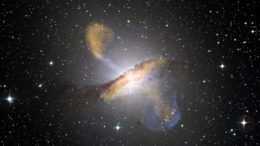From the boundary of our solar system to the surroundings of exploding stars, astrophysical shocks can accelerate particles to relativistic speeds and produce high-energy radiation. Now, astronomers may have detected a new source of gamma rays from the shock that forms where ultrafast outflows and interstellar gas meet.
Outer-Space Outflows

This composite image reveals Centaurus A, a galaxy with an active nucleus spewing fast-moving jets into its surroundings. Active galactic nuclei like this one produce extremely high-energy photons. [ESO/WFI (Optical); MPIfR/ESO/APEX/A.Weiss et al. (Submillimeter); NASA/CXC/CfA/R.Kraft et al. (X-ray)]
If UFOs billowing out into interstellar space create shocks where particles can be accelerated, they should generate gamma-ray luminosities of 1033 Joules per second, but so far astronomers have only detected them at X-ray wavelengths. The vast distances between galaxies are working against us: from our earthly vantage point, a collecting area of roughly 8,400 square meters would capture just one photon with an energy greater than a gigaelectronvolt per hour from a typical UFO.

Test-statistic (TS) values derived for the stacked Fermi LAT observations. Large TS values indicate that the observations are likely, given the model. [Fermi LAT Collaboration 2021]
Stacking Gamma-Ray Snapshots
To detect these elusive UFOs at gamma-ray wavelengths, an international group of scientists used data from the Fermi Large Area Telescope (LAT), an instrument on the Fermi Gamma Ray Space Telescope spacecraft. A single UFO is about 2.5 times fainter than the dimmest source detected by Fermi LAT, but the team hoped to draw out a signal by combining observations of multiple galaxies for which UFOs have been detected at X-ray wavelengths.
The team approached this problem by modeling the combined gamma-ray spectrum. For each set of model parameters, they calculated a test statistic — a quantity that describes how likely it is to have obtained the data if the emission from the source follows the model they tested. The larger the test statistic, the more likely it is that the signal is well-described by the model. The combined observations yielded a maximum test statistic of 30.1 — equivalent to a 5.1-sigma detection.
Double Checking

Fermi observations revealed the presence of two bubbles extending 25,000 light-years above and below the plane of the Milky Way. [NASA/DOE/Fermi LAT/D. Finkbeiner et al.]
The detection of gamma-ray emission from UFOs supports the theory that these massive outflows produce shocks that are sites of particle acceleration. Although today’s article explored distant galaxies, UFOs might have had an impact closer to home as well; the Fermi LAT team suggests that past outflows from the Milky Way’s supermassive black hole may have created the enormous bubbles extending above and below our galaxy seen previously by Fermi and the eROSITA instrument.
Citation
“Gamma Rays from Fast Black-Hole Winds,” M. Ajello et al 2021 ApJ 921 144. doi:10.3847/1538-4357/ac1bb2
